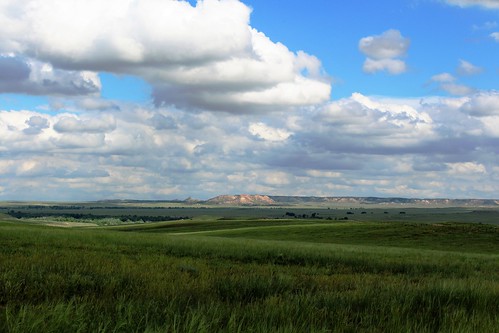
Many know about America’s Great Plains, the vast, far-as-you-can-see mostly flat lands in the country’s interior west of the Mississippi River and east of the Rocky Mountains, consisting of prairie, steppe and grasslands. The 20 national grasslands and the Midewin National Tallgrass Prairie are part of this heartland tapestry, rich in stories about history, ecological health, business and job opportunities, adventures in recreation, and now—part of the U.S. Forest Service’s urgent mission to conserve open space.
During America’s westward expansion in the 1800s, a once teeming herd of bison was largely eliminated as ranchers, soldiers, prospectors and railroad builders pushed back the last frontier. The Homestead Act of 1862 brought almost six million settlers who replaced grass with crops more beneficial to their economic aspirations.
Prolonged drought, bitter winters and overly plowed land exposed rich dark topsoil to incessant dry winds. Together these factors created what came to be known as the Dust Bowl of the 1930s, further exasperating the harsh economic downturn of the Great Depression.
Emergency legislative measures to save the farmers and settlers allowed the federal government to purchase and restore damaged lands and to resettle destitute families. Following this conservation trend, in June 1960, the national grasslands were created under Forest Service stewardship.
Today, these grasslands tell an outstanding conservation success story. Revegetated to provide for soil and water conservation, these intermingled public and private lands are managed to conserve the natural resources of grass, water and wildlife habitat. Clean water flows off restored watersheds to nourish communities miles downstream. Wildlife thrives in reborn habitats and the soil has regained its fertility. Livestock ponds expand the range of many wildlife species by providing water while allowing for more cattle to graze.
National grasslands are managed for multiple sustainable uses, while producing a variety of goods and services to help maintain rural economies and lifestyles. Rich in mineral, oil and gas resources, they also provide diverse recreational uses such as mountain bicycling, hiking, hunting, fishing, photographing, birding, and sightseeing.
Yet the open space these lands offer face new challenges. They lie within grassland ecosystems that are becoming scarcer every day.
At one time, grasslands covered approximately 500,000 square miles in the United States. Today only about two percent or 10,000 square miles remain and the Forest Service manages nearly 60 percent or 6,000 of those miles. The National Forests on the Edge publication estimates that 21 million acres of private rural lands near national forests and grasslands will experience substantial housing density increases by 2030.
For almost 80 years, the laws and policies that guide the US Forest Service have focused on conserving open space as part of the grasslands mission. The aesthetic beauty, economic value, and social benefits of open spaces are a keystone in the Forest Service’s stewardship of these national treasures.



